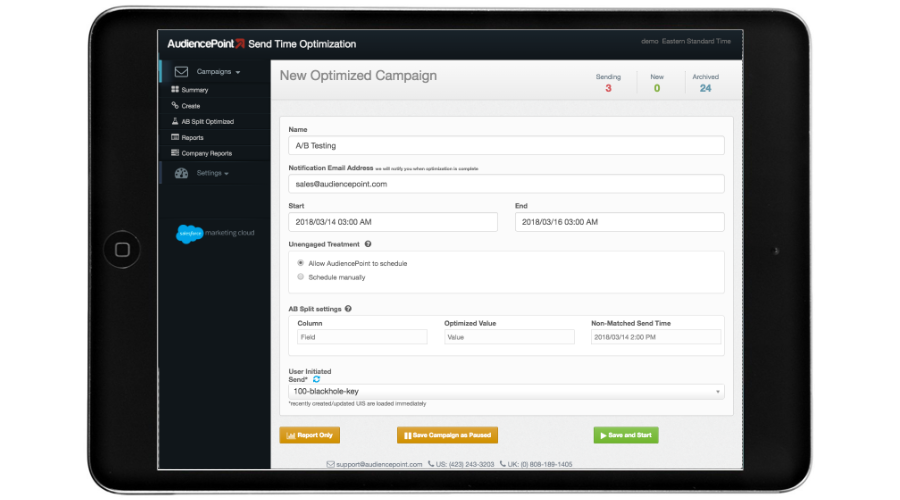AudiencePoint is thrilled to announce our new integration with Klaviyo! AudiencePoint is looking for partners to pilot our...
Have you heard the term inbox placement and wondered what it means and how it relates to email marketing? Inbox placement rate can significantly impact the success of your email campaigns, so it is essential to learn about it.
Fortunately, you’ve found the right place. This article will provide a complete guide to inbox placement, how it impacts email marketing, and how you can optimize your strategy to improve your placement rates. Keep reading for all the information about our email address verification tool.
What Does Inbox Placement Mean?
When you check your emails, you probably know that there are several folders and places where the emails you receive can end up. Most notably, emails will go to either your primary inbox or the spam folder.
On top of that, email providers like Gmail have implemented additional folders for content like “promotions” and “social,” where email content can end up as well.
That’s what inbox placement refers to. The goal is not just to measure how many emails are delivered to your customers but how many of them reach them where they’ll actually see it.
What Is Inbox Placement Rate (IPR)?
When you check your emails, you probably know that there are several folders and places where the emails you receive can end up. Most notably, emails will go to either your primary inbox or the spam folder.
On top of that, mailbox providers like Gmail have implemented additional folders for content like “promotions” and “social,” where email content can end up as well.
That’s where inbox placement comes into play. The goal is not just to measure how many emails are delivered to your customers but how many of them reach them where they’ll actually see it.
If you’re still wondering what inbox placement means in the context of email marketing, the exact definition is the percentage of emails that end up in subscribers’ primary inboxes (as opposed to the junk folder) out of the total number of emails that were delivered.
The keyword that you should take note of in that definition is “delivered.” Inbox placement is specific to the content that is actually delivered to subscribers, so the emails that bounce aren’t calculated into the equation. This makes it a bit different from other email delivery metrics like deliverability rate that do account for bounce rate in email marketing.
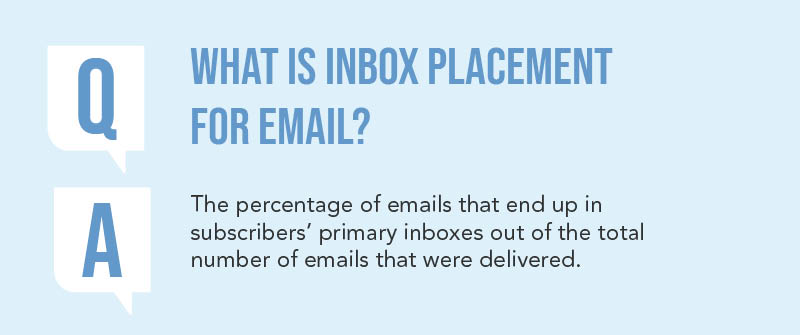
Is Inbox Placement the Same as Deliverability?
Inbox placement is not the same thing as deliverability. Instead, it is a subsection of deliverability that accounts for a more specified portion of it. Inbox placement is particularly useful because it has a bigger focus on how many of your emails end up in your subscriber’s spam folders.
What Is the Difference Between Inbox Placement and Deliverability?
The main difference between inbox placement and email deliverability is that deliverability has a bigger focus on whether an email bounces or not, whereas placement focuses more on which specific area of a subscriber’s email account the content is going to.
Both of these metrics can be very useful for their own unique purposes. For instance, email marketers that have a lot of content bounce will want to pay attention to deliverability rates to ensure the efforts they’re making to improve it are working.
That said, the main downfall of deliverability is that it doesn’t consider where the emails end up after they’re delivered because an email that lands in a spam folder will still count as delivered.
If you’re looking for a solution, our tool ListFit can help. It provides an inbox placement score, so you can get a better understanding of where your content is ending up after it is delivered.
What Is the Formula for Email Delivery Rate?
The formula for email delivery rate is pretty simple. It’s the number of delivered emails divided by the total number of emails sent. Most well-rounded email marketing tools are equipped to help you calculate delivery rate, so you don’t have to track down how many of your emails bounced on your own, which would be a pretty tedious process.
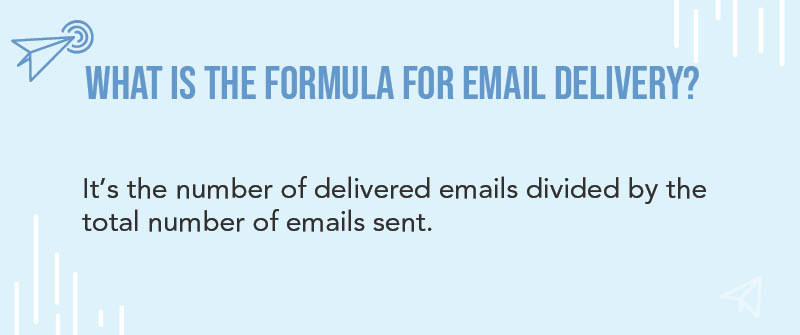
How Do I Check My Inbox Placement Rate?
The best way to check your inbox placement rate is also through email marketing tools. As mentioned, our tool ListFit at AudiencePoint can help with that by providing you with an inbox placement score. It’s also more accurate than other solutions available on the market that offer an inbox placement test.
When you use other inbox placement tools, they use seed lists. That means they’re just testing to estimate where emails land in specific inboxes that are used through the tool. It doesn’t provide you with results for how they’re received by the actual customers on your list.
Our tool ListFit works differently. It leverages auto-open data to determine if an email actually hits the spam folder for a significant portion of your email list. It provides you with real results so you can understand if you have problems that need to be addressed and the best strategies to get you optimal results.
What Is Considered a High Email Delivery Rate?
Typically, most email marketers consider 95% and above to be a high or good email delivery rate. The goal is always to shoot for as close to 100% as you can get, so most marketers will find that consistent effort and monitoring is a good idea to ensure the best results, especially as your subscriber list grows.
Using tools like AudiencePoint’s insight software is a great way to ensure you maintain a high delivery rate long-term.
Our insight software consistently tracks subscriber activity. That way, you’ll know when subscribers become inactive so you can re-engage them or remove any dormant emails from your list. Plus, it’ll help you maintain high engagement rates and validate any new subscribers who are added to ensure they are real and active.
What an Inbox Placement Tool?
An inbox placement tool, which some may refer to as an email spam checker tool, is a way for you to get an estimate of where your content is being placed when delivered and to analyze the content you’re about to send to see how likely it is to end up in spam folders.
Essentially, these tools are software programs that can quickly run several processes in the background that help estimate these metrics. They’ll track aspects like how major inbox providers will interpret content, common spam filters, whether your SPF, DKIM, and DMARC are set up correctly, and more.
Then if the tool comes back saying that a high percentage of your content is landing in spam folders or an email you’re about to send is more likely to be marked as spam, you can go back to the drawing board to figure out what you can do better.
Having these kinds of spam email trackers can help you keep tabs on when your percentage of spam emails is getting out of hand.
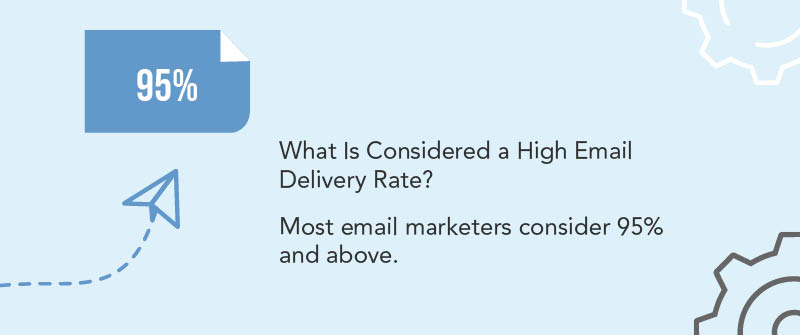
How Can I Improve My Inbox Placement?
If you’ve realized that your inbox placement rate is low, there are several steps you can take to improve it. Plus, it can also be helpful to take action to prevent poor placement rates in the future. Here are some of the primary measures you can put in place within your email marketing strategy.
1. Send Content That Provides Value to Avoid Spam Filters
The main thing you should always be concerned about when considering email placement, deliverability, engagement, conversions, and every other essential metric is value. Value is the crux of successful email marketing campaigns.
Before you send an email to subscribers, ask yourself honestly, is this offering value? Would you be interested to read that content if it landed in your inbox? If not, you may want to go back to the drawing board.
Typically, a great way to provide value is by answering common questions and solving common problems that consumers in your industry often experience. When you help someone solve a problem, it not only makes your brand more memorable but also helps establish you as a knowledgeable authority in the customer’s eyes.
2. Clean Up Your Email List
Having fake emails on your list from bots or consumers trying to get around account signup requirements can hurt deliverability and email placement in the long run.
When you send out email campaigns, these dormant or inactive accounts will start bouncing. Suddenly, that triggers spam filters and can hurt your engagement even more. It’s a snowball effect that can really get out of control quickly if you don’t take the right measures to stop or prevent it.
That’s why our tools at AudiencePoint will help you clean up your list and suppress any dormant emails from sending to improve deliverability and placement. Plus, it’s not only a great solution in the short-term but can also be used as a preventative measure to ensure you maintain great deliverability for years to come.
3. Optimize Send Times
Optimizing when you send content will also be highly beneficial in many ways. First, it boosts engagement which will have a direct impact on your placement over the long term. When you send emails at a time when your subscribers are most likely to engage, they’ll more readily open your content and take the desired actions you’re looking for.
This signals \to email providers that subscribers are happy about receiving content from you increasing your sender reputation with them, which in turn keeps you out of the spam folder.
If you’re looking for help with this aspect, our Send Time Optimization tool through AudiencePoint can provide you with actionable insights that make implementing it easy.
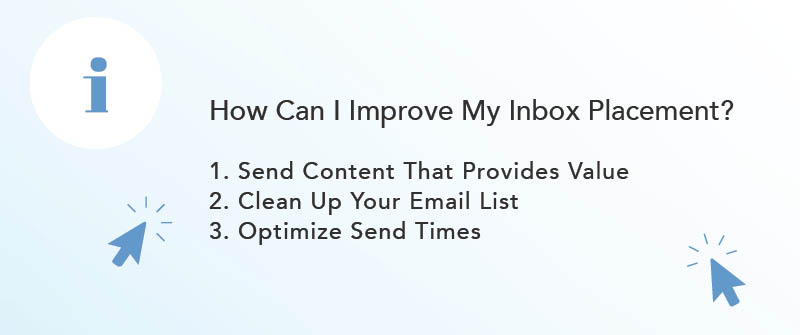
How AudiencePoint Can Help You Avoid The Spam Folder
Marketers who want a long-term inbox placement, deliverability, and email engagement solution for success will benefit from using AudiencePoint.
Our email insight software stands out as the right choice because it doesn’t rely purely on seedlists to measure your inbox placement. Instead our inbox placement solution is able to see if your mail is landing in your customers’ spam folders.
It’ll help you optimize send times, re-engage inactive subscribers, segment your email list, and much more that all have positive benefits on your sender reputation and help you achieve your desired results.
Contact us today to learn more about how AudiencePoint can help with your inbox placement results.




